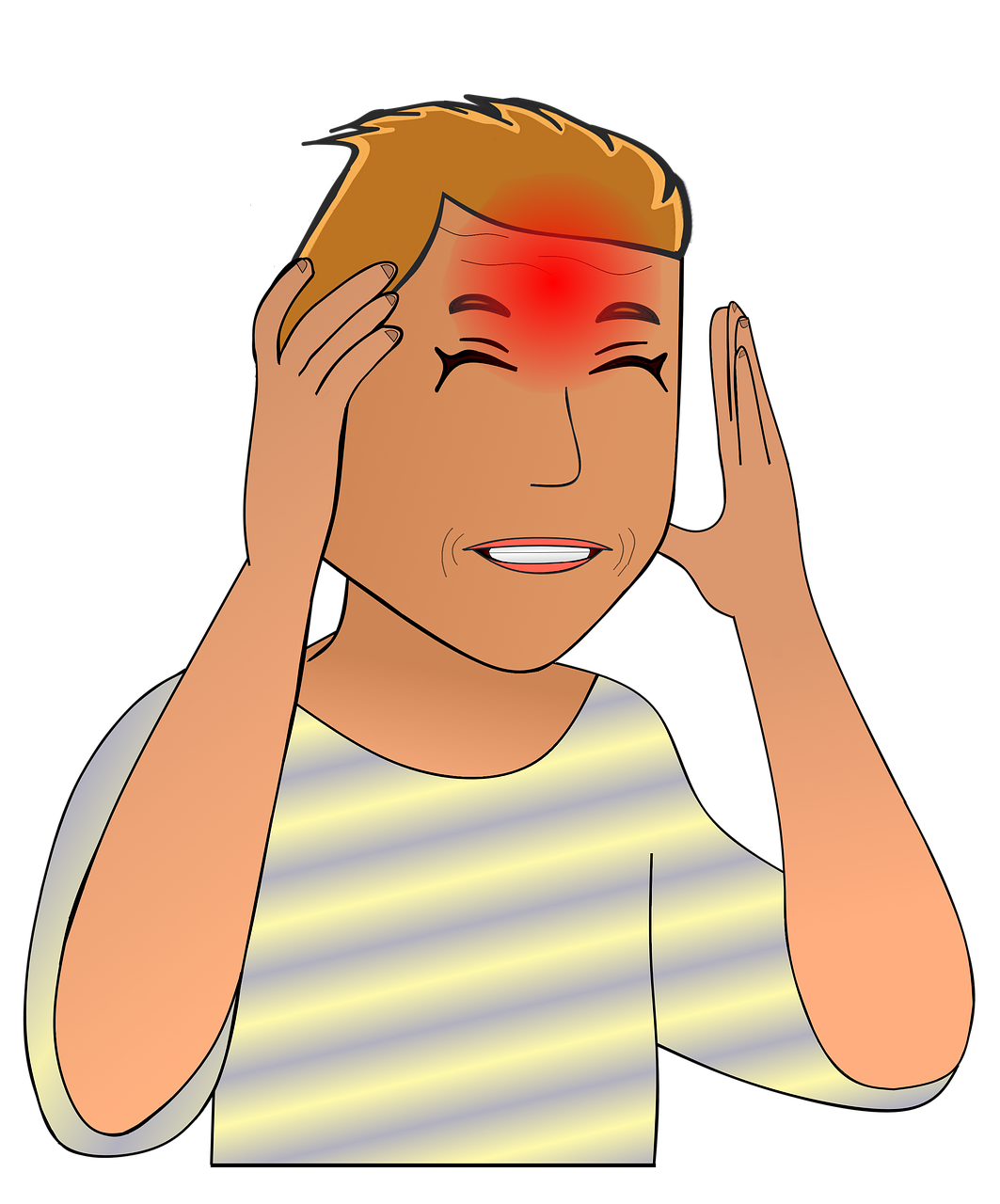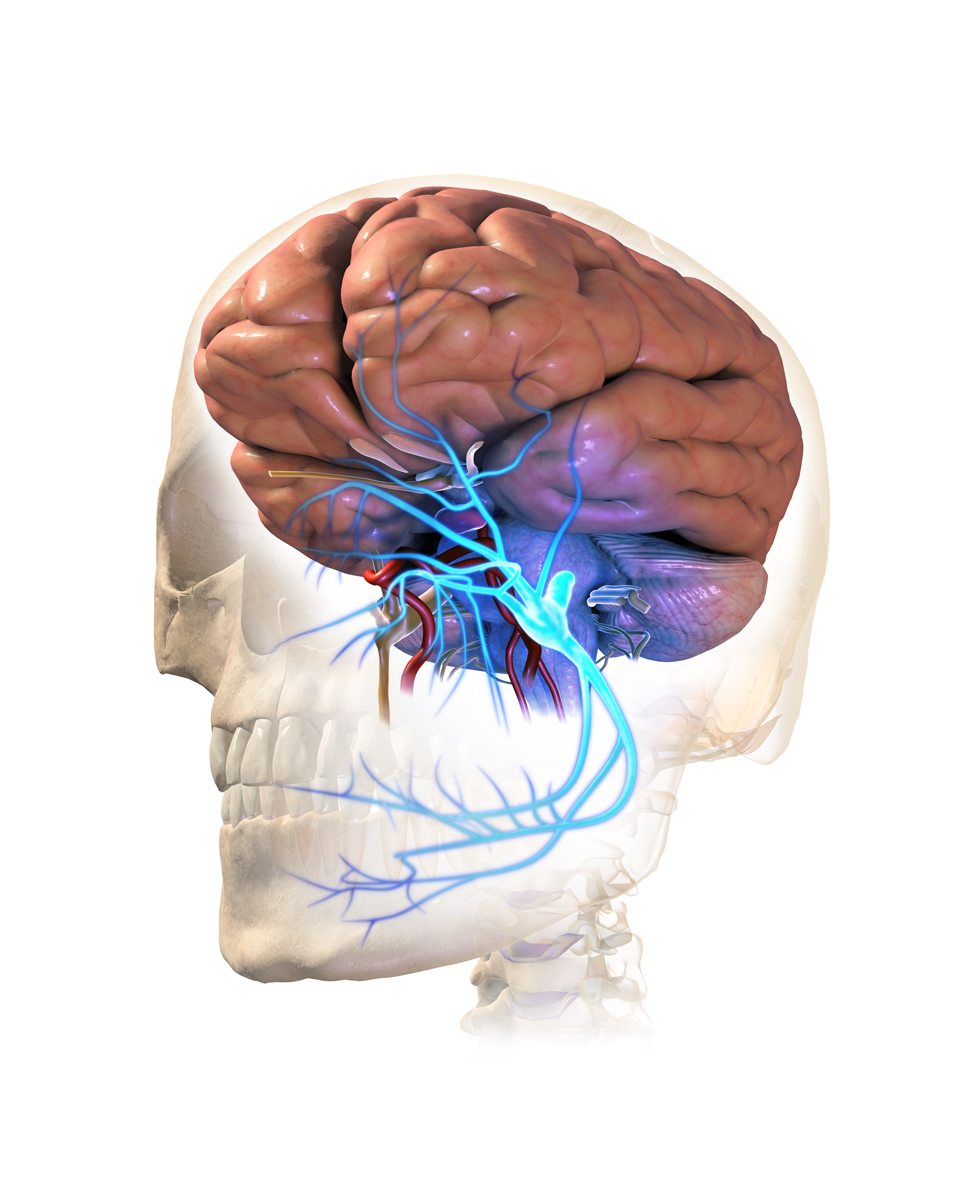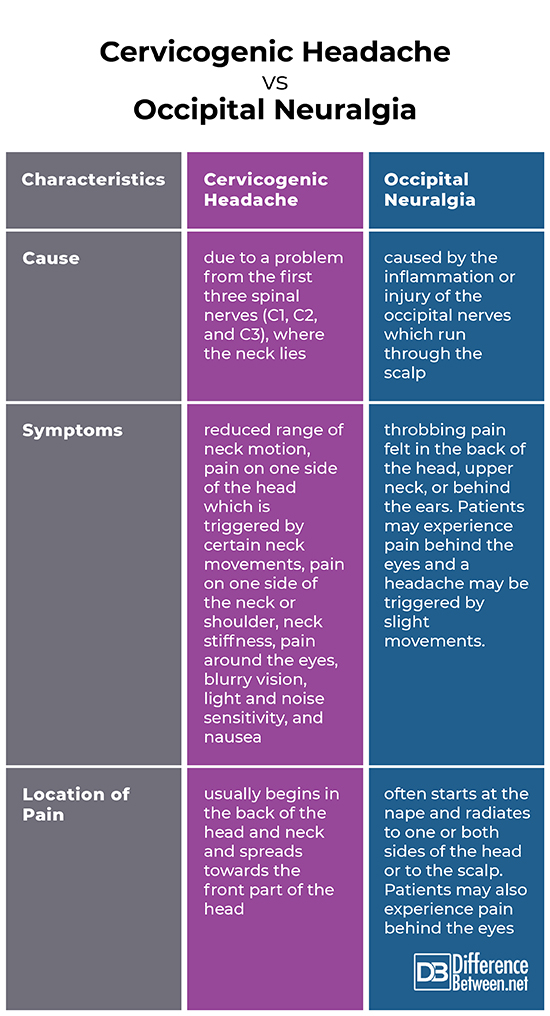Difference Between Cervicogenic Headache and Occipital Neuralgia
Cervicogenic headache and occipital neuralgia are both concerned with pain on the neck and head. Specifically, cervicogenic headache is characterized by reduced range of neck motion, pain on one side of the head which is triggered by certain neck movements, pain on one side of the neck or shoulder, neck stiffness, pain around the eyes, blurry vision, light and noise sensitivity, and nausea (Eske, 2019). In comparison, occipital neuralgia is characterized by a piercing or throbbing pain in the upper neck, back of the head (usually on one side), and behind the ears. Others may feel the pain behind the eyes, on the forehead, and in the scalp. The following discussions further delve into their distinctions.

What is Cervicogenic Headache?
Cervicogenic headache or neck headache is a secondary headache as it is caused by an underlying condition like infections, high blood pressure, arthritis of the upper spine, tumors, and neck injury (i.e. whiplash). It is particularly due to structural problems with the cervical vertebrae. The symptoms include reduced range of neck motion, pain on one side of the head which is triggered by certain neck movements, pain on one side of the neck or shoulder, neck stiffness, pain around the eyes, blurry vision, light and noise sensitivity, and nausea. The pain usually begins in the back of the head and neck and spreads towards the front part of the head. The treatments include medications (non-steroidal anti-inflammatories, muscle relaxers, antiseizure medications, and antidepressants), physical therapy, radiofrequency ablation (using radio waves to deaden the nerve which transmits pain signals to the brain), nerve blocks (injecting pain-numbing medicine), neuromodulation (a surgical procedure involving electrodes on the neck) and home remedies (yoga and deep breathing technics) (Eske, 2019).

What is Occipital Neuralgia?
Occipital Neuralgia can be a primary or a secondary headache. Unlike a secondary headache, primary headache is not due to another medical condition such as migraines and cluster headaches. The underlying diseases may include infections, blood vessel inflammation, gout, diabetes, tumors, cervical disc disease, compression of the occipital nerves, and osteoarthritis of the upper cervical spine. It may be caused by neck muscle tightness or pinched nerves. It must be noted that many cases have unknown origins. The pain is often described as throbbing, piercing, migraine-like, or shock-like felt in the back of the head, upper neck, or behind the ears. It often starts at the nape and radiates to one or both sides of the head or to the scalp. Patients may experience pain behind the eyes and a headache may be triggered by slight movements. The treatments include oral medications (anti-inflammatory, muscle relaxants, and anti-convulsant), percutaneous nerve blocks, botulinum toxin injections, physical therapy, surgery (occipital nerve stimulation, spinal cord stimulation, and C2,3 Ganglionectomy), and home remedies such as placing of heating pads (Pilitsis & Khazen, 2020).
Difference between Cervicogenic Headache and Occipital Neuralgia
Cause
Cervicogenic headache is due to a problem from the first three spinal nerves (C1, C2, and C3), where the neck lies (Doherty, 2020). As for occipital neuralgia, it is caused by the inflammation or injury of the occipital nerves which run through the scalp (Pilitsis & Khazen, 2020).
Symptoms
Cervicogenic headache is characterized by reduced range of neck motion, pain on one side of the head which is triggered by certain neck movements, pain on one side of the neck or shoulder, neck stiffness, pain around the eyes, blurry vision, light and noise sensitivity, and nausea (Eske, 2019). In comparison occipital neuralgia is characterized by throbbing pain felt in the back of the head, upper neck, or behind the ears. Patients may experience pain behind the eyes and a headache may be triggered by slight movements (Pilitsis & Khazen, 2020).
Location of Pain
Regarding cervicogenic headache, the pain usually begins in the back of the head and neck and spreads towards the front part of the head (Eske, 2019). As for occipital neuralgia, the pain is often felt in the back of the head, upper neck, or behind the ears. It often starts at the nape and radiates to one or both sides of the head or to the scalp. Patients may also experience pain behind the eyes (Pilitsis & Khazen, 2020).
Cervicogenic Headache vs Occipital Neuralgia

Summary
- Cervicogenic headache and occipital neuralgia are both concerned with pain on the neck and head.
- Cervicogenic headache is due to a problem from the first three spinal nerves while occipital neuralgia is caused by the inflammation or injury of the occipital nerves.
- Cervicogenic headache is characterized by reduced range of neck motion, pain on one side of the head, neck or shoulder, neck stiffness, pain around the eyes, blurry vision, light and noise sensitivity, and nausea. In comparison occipital neuralgia is characterized by throbbing pain in the back of the head, upper neck, behind the eyes, and/or behind the ears.
- The location of the pain in cervicogenic headache usually begins in the back of the head and neck and spreads towards the front part of the head (Eske, 2019). As for occipital neuralgia, the pain is often felt in the back of the head, upper neck, or behind the ears.
- Difference Between Hematoma and Melanoma - February 9, 2023
- Difference Between Bruising and Necrosis - February 8, 2023
- Difference Between Brain Hematoma and Brain Hemorrhage - February 8, 2023
Search DifferenceBetween.net :
Leave a Response
References :
[0]Doherty, Colleen. Cerviogenic Headache Overview. Very Well Health, 2020, https://www.verywellhealth.com/how-a-headache-may-come-from-your-neck-1719582
[1]Eske, Jamie. What is cervicogenic headache? Medical News Today, 2019, https://www.medicalnewstoday.com/articles/324108
[2]Pilitsis, Julie and Khazen, Olga. Occipital Neuralgia. American Association of Neurological Surgeons, 2020, https://www.aans.org/en/Patients/Neurosurgical-Conditions-and-Treatments/Occipital-Neuralgia
[3]Image credit: https://commons.wikimedia.org/wiki/File:Trigeminal_Neuralgia.png
[4]Image credit: https://pixabay.com/de/illustrations/stress-nervenschmerzen-kopfschmerzen-4498569/
